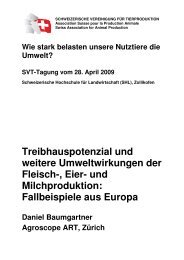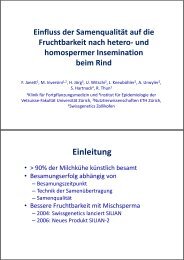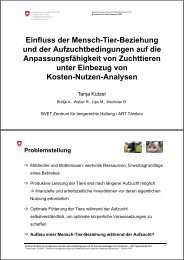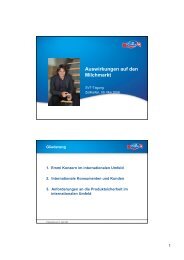Genomische Zuchtwertschätzung: Wer macht was? - svt-asp.ch
Genomische Zuchtwertschätzung: Wer macht was? - svt-asp.ch
Genomische Zuchtwertschätzung: Wer macht was? - svt-asp.ch
Sie wollen auch ein ePaper? Erhöhen Sie die Reichweite Ihrer Titel.
YUMPU macht aus Druck-PDFs automatisch weboptimierte ePaper, die Google liebt.
<strong>Genomis<strong>ch</strong>e</strong> <strong>Zu<strong>ch</strong>twerts<strong>ch</strong>ätzung</strong>:<strong>Wer</strong> <strong>ma<strong>ch</strong>t</strong> <strong>was</strong>?C. Strickerstricker@genetics-network.<strong>ch</strong>agn Genetics GmbH, Davos
Ablauf◮ Einleitung, Was ist genomis<strong>ch</strong>e ZWS, Christian Stricker, agnGenetics GmbH◮ Modellierung von Haplotypen, Christian Stricker, agn GeneticsGmbH◮ Aktuelle Arbeiten zur genomis<strong>ch</strong>en Selektion bei Qualitas.Birgit Gredler, Qualitas AG, Zug◮ Projektstand genomis<strong>ch</strong>e ZWS beim S<strong>ch</strong>wein. Andreas Hofer,SUISAG, Sempa<strong>ch</strong>◮ Genomweite Assoziationsstudien in vers<strong>ch</strong>iedenenRassen/Spezies. Christine Flury, HAFL, Zollikofen
Ablauf◮ Einleitung, Was ist genomis<strong>ch</strong>e ZWS, Christian Stricker, agnGenetics GmbH◮ Modellierung von Haplotypen, Christian Stricker, agn GeneticsGmbH◮ Aktuelle Arbeiten zur genomis<strong>ch</strong>en Selektion bei Qualitas.Birgit Gredler, Qualitas AG, Zug◮ Projektstand genomis<strong>ch</strong>e ZWS beim S<strong>ch</strong>wein. Andreas Hofer,SUISAG, Sempa<strong>ch</strong>◮ Genomweite Assoziationsstudien in vers<strong>ch</strong>iedenenRassen/Spezies. Christine Flury, HAFL, Zollikofen
Ablauf◮ Einleitung, Was ist genomis<strong>ch</strong>e ZWS, Christian Stricker, agnGenetics GmbH◮ Modellierung von Haplotypen, Christian Stricker, agn GeneticsGmbH◮ Aktuelle Arbeiten zur genomis<strong>ch</strong>en Selektion bei Qualitas.Birgit Gredler, Qualitas AG, Zug◮ Projektstand genomis<strong>ch</strong>e ZWS beim S<strong>ch</strong>wein. Andreas Hofer,SUISAG, Sempa<strong>ch</strong>◮ Genomweite Assoziationsstudien in vers<strong>ch</strong>iedenenRassen/Spezies. Christine Flury, HAFL, Zollikofen
Ablauf◮ Einleitung, Was ist genomis<strong>ch</strong>e ZWS, Christian Stricker, agnGenetics GmbH◮ Modellierung von Haplotypen, Christian Stricker, agn GeneticsGmbH◮ Aktuelle Arbeiten zur genomis<strong>ch</strong>en Selektion bei Qualitas.Birgit Gredler, Qualitas AG, Zug◮ Projektstand genomis<strong>ch</strong>e ZWS beim S<strong>ch</strong>wein. Andreas Hofer,SUISAG, Sempa<strong>ch</strong>◮ Genomweite Assoziationsstudien in vers<strong>ch</strong>iedenenRassen/Spezies. Christine Flury, HAFL, Zollikofen
Ablauf◮ Einleitung, Was ist genomis<strong>ch</strong>e ZWS, Christian Stricker, agnGenetics GmbH◮ Modellierung von Haplotypen, Christian Stricker, agn GeneticsGmbH◮ Aktuelle Arbeiten zur genomis<strong>ch</strong>en Selektion bei Qualitas.Birgit Gredler, Qualitas AG, Zug◮ Projektstand genomis<strong>ch</strong>e ZWS beim S<strong>ch</strong>wein. Andreas Hofer,SUISAG, Sempa<strong>ch</strong>◮ Genomweite Assoziationsstudien in vers<strong>ch</strong>iedenenRassen/Spezies. Christine Flury, HAFL, Zollikofen
Quick Reminder of Genomic Prediction◮ 1k,... >>100k SNP typisiert◮ 1k,
Quick Reminder of Genomic Prediction◮ 1k,... >>100k SNP typisiert◮ 1k,
Quick Reminder of Genomic Prediction◮ 1k,... >>100k SNP typisiert◮ 1k,
Quick Reminder of Genomic Prediction◮ 1k,... >>100k SNP typisiert◮ 1k,
Quick Reminder of Genomic Prediction◮ 1k,... >>100k SNP typisiert◮ 1k,
Quick Reminder of Genomic Prediction◮ 1k,... >>100k SNP typisiert◮ 1k,
Quick Reminder of Genomic Prediction◮ 1k,... >>100k SNP typisiert◮ 1k,
Quick Reminder of Genomic Prediction◮ 1k,... >>100k SNP typisiert◮ 1k,
Quick Reminder of Genomic Prediction◮ 1k,... >>100k SNP typisiert◮ 1k,
Quick Reminder of Genomic Prediction◮ 1k,... >>100k SNP typisiert◮ 1k,
Quick Reminder of Genomic Prediction, cont.◮ Nejati-Javaremi et al. (1997): Animal Effect Modely = Xβ + Zu + e (2)◮ y, Xβ, e as above in model (1)◮ Z incidence matrix relating animal effects to y ,◮ u vector of random animal effects◮ Solutions usually by MMEs◮ use G = ZZ’/2 ∑ pq instead of A◮ requires G −1 (instead of A −1 )◮ G is dense, cannot be inverted, when >50k animalsgenotyped....◮ Legarra et al. (2009), Christensen & Lund (2010) combined Afor ungenotyped animals with G for genotyped animals◮ requires G −1 and A −122, dense and not easy!◮ need alternatives when > 50k animals genotyped
Quick Reminder of Genomic Prediction, cont.◮ Nejati-Javaremi et al. (1997): Animal Effect Modely = Xβ + Zu + e (2)◮ y, Xβ, e as above in model (1)◮ Z incidence matrix relating animal effects to y ,◮ u vector of random animal effects◮ Solutions usually by MMEs◮ use G = ZZ’/2 ∑ pq instead of A◮ requires G −1 (instead of A −1 )◮ G is dense, cannot be inverted, when >50k animalsgenotyped....◮ Legarra et al. (2009), Christensen & Lund (2010) combined Afor ungenotyped animals with G for genotyped animals◮ requires G −1 and A −122, dense and not easy!◮ need alternatives when > 50k animals genotyped
Quick Reminder of Genomic Prediction, cont.◮ Nejati-Javaremi et al. (1997): Animal Effect Modely = Xβ + Zu + e (2)◮ y, Xβ, e as above in model (1)◮ Z incidence matrix relating animal effects to y ,◮ u vector of random animal effects◮ Solutions usually by MMEs◮ use G = ZZ’/2 ∑ pq instead of A◮ requires G −1 (instead of A −1 )◮ G is dense, cannot be inverted, when >50k animalsgenotyped....◮ Legarra et al. (2009), Christensen & Lund (2010) combined Afor ungenotyped animals with G for genotyped animals◮ requires G −1 and A −122, dense and not easy!◮ need alternatives when > 50k animals genotyped
Quick Reminder of Genomic Prediction, cont.◮ Nejati-Javaremi et al. (1997): Animal Effect Modely = Xβ + Zu + e (2)◮ y, Xβ, e as above in model (1)◮ Z incidence matrix relating animal effects to y ,◮ u vector of random animal effects◮ Solutions usually by MMEs◮ use G = ZZ’/2 ∑ pq instead of A◮ requires G −1 (instead of A −1 )◮ G is dense, cannot be inverted, when >50k animalsgenotyped....◮ Legarra et al. (2009), Christensen & Lund (2010) combined Afor ungenotyped animals with G for genotyped animals◮ requires G −1 and A −122, dense and not easy!◮ need alternatives when > 50k animals genotyped
Quick Reminder of Genomic Prediction, cont.◮ Nejati-Javaremi et al. (1997): Animal Effect Modely = Xβ + Zu + e (2)◮ y, Xβ, e as above in model (1)◮ Z incidence matrix relating animal effects to y ,◮ u vector of random animal effects◮ Solutions usually by MMEs◮ use G = ZZ’/2 ∑ pq instead of A◮ requires G −1 (instead of A −1 )◮ G is dense, cannot be inverted, when >50k animalsgenotyped....◮ Legarra et al. (2009), Christensen & Lund (2010) combined Afor ungenotyped animals with G for genotyped animals◮ requires G −1 and A −122, dense and not easy!◮ need alternatives when > 50k animals genotyped
Quick Reminder of Genomic Prediction, cont.◮ Nejati-Javaremi et al. (1997): Animal Effect Modely = Xβ + Zu + e (2)◮ y, Xβ, e as above in model (1)◮ Z incidence matrix relating animal effects to y ,◮ u vector of random animal effects◮ Solutions usually by MMEs◮ use G = ZZ’/2 ∑ pq instead of A◮ requires G −1 (instead of A −1 )◮ G is dense, cannot be inverted, when >50k animalsgenotyped....◮ Legarra et al. (2009), Christensen & Lund (2010) combined Afor ungenotyped animals with G for genotyped animals◮ requires G −1 and A −122, dense and not easy!◮ need alternatives when > 50k animals genotyped
Quick Reminder of Genomic Prediction, cont.◮ Nejati-Javaremi et al. (1997): Animal Effect Modely = Xβ + Zu + e (2)◮ y, Xβ, e as above in model (1)◮ Z incidence matrix relating animal effects to y ,◮ u vector of random animal effects◮ Solutions usually by MMEs◮ use G = ZZ’/2 ∑ pq instead of A◮ requires G −1 (instead of A −1 )◮ G is dense, cannot be inverted, when >50k animalsgenotyped....◮ Legarra et al. (2009), Christensen & Lund (2010) combined Afor ungenotyped animals with G for genotyped animals◮ requires G −1 and A −122, dense and not easy!◮ need alternatives when > 50k animals genotyped
Quick Reminder of Genomic Prediction, cont.◮ Nejati-Javaremi et al. (1997): Animal Effect Modely = Xβ + Zu + e (2)◮ y, Xβ, e as above in model (1)◮ Z incidence matrix relating animal effects to y ,◮ u vector of random animal effects◮ Solutions usually by MMEs◮ use G = ZZ’/2 ∑ pq instead of A◮ requires G −1 (instead of A −1 )◮ G is dense, cannot be inverted, when >50k animalsgenotyped....◮ Legarra et al. (2009), Christensen & Lund (2010) combined Afor ungenotyped animals with G for genotyped animals◮ requires G −1 and A −122, dense and not easy!◮ need alternatives when > 50k animals genotyped
Quick Reminder of Genomic Prediction, cont.◮ Nejati-Javaremi et al. (1997): Animal Effect Modely = Xβ + Zu + e (2)◮ y, Xβ, e as above in model (1)◮ Z incidence matrix relating animal effects to y ,◮ u vector of random animal effects◮ Solutions usually by MMEs◮ use G = ZZ’/2 ∑ pq instead of A◮ requires G −1 (instead of A −1 )◮ G is dense, cannot be inverted, when >50k animalsgenotyped....◮ Legarra et al. (2009), Christensen & Lund (2010) combined Afor ungenotyped animals with G for genotyped animals◮ requires G −1 and A −122, dense and not easy!◮ need alternatives when > 50k animals genotyped
Quick Reminder of Genomic Prediction, cont.◮ Nejati-Javaremi et al. (1997): Animal Effect Modely = Xβ + Zu + e (2)◮ y, Xβ, e as above in model (1)◮ Z incidence matrix relating animal effects to y ,◮ u vector of random animal effects◮ Solutions usually by MMEs◮ use G = ZZ’/2 ∑ pq instead of A◮ requires G −1 (instead of A −1 )◮ G is dense, cannot be inverted, when >50k animalsgenotyped....◮ Legarra et al. (2009), Christensen & Lund (2010) combined Afor ungenotyped animals with G for genotyped animals◮ requires G −1 and A −122, dense and not easy!◮ need alternatives when > 50k animals genotyped
Quick Reminder of Genomic Prediction, cont.◮ Nejati-Javaremi et al. (1997): Animal Effect Modely = Xβ + Zu + e (2)◮ y, Xβ, e as above in model (1)◮ Z incidence matrix relating animal effects to y ,◮ u vector of random animal effects◮ Solutions usually by MMEs◮ use G = ZZ’/2 ∑ pq instead of A◮ requires G −1 (instead of A −1 )◮ G is dense, cannot be inverted, when >50k animalsgenotyped....◮ Legarra et al. (2009), Christensen & Lund (2010) combined Afor ungenotyped animals with G for genotyped animals◮ requires G −1 and A −122, dense and not easy!◮ need alternatives when > 50k animals genotyped
Warum funktionieren MEM◮ Fernando (1998) MEM equivalent to AEM, wenn ynormalverteilt.◮ Poster
Warum funktionieren MEM◮ Fernando (1998) MEM equivalent to AEM, wenn ynormalverteilt.◮ Poster
Problems of Genomic Prediction◮ Anzahl Tiere >> 50’000◮ MEM anwendbar, aber MCMC CPU-intensiv!◮ AEM unmögli<strong>ch</strong>, wegen G−1◮ AEM ohne G −1 ⇒ Fors<strong>ch</strong>ungsprojekt Fernando& Garrick(2013/14)◮ Anzahl SNPs >> 50’000◮ Genauigkeit aufgrund LD → ermögli<strong>ch</strong>t across breed evaluation◮ SNP Arrays mit Markern in LD = redundante Info analysieren◮ Imputation = redundante Info auf ni<strong>ch</strong>t typisierte Tiereübertragen, damit bestehende Software genutzt werden kann◮ variable reduction methods (Bayes B) oder Konzentration derMarkerinfo auf segregierende Haplotypen
Problems of Genomic Prediction◮ Anzahl Tiere >> 50’000◮ MEM anwendbar, aber MCMC CPU-intensiv!◮ AEM unmögli<strong>ch</strong>, wegen G−1◮ AEM ohne G −1 ⇒ Fors<strong>ch</strong>ungsprojekt Fernando& Garrick(2013/14)◮ Anzahl SNPs >> 50’000◮ Genauigkeit aufgrund LD → ermögli<strong>ch</strong>t across breed evaluation◮ SNP Arrays mit Markern in LD = redundante Info analysieren◮ Imputation = redundante Info auf ni<strong>ch</strong>t typisierte Tiereübertragen, damit bestehende Software genutzt werden kann◮ variable reduction methods (Bayes B) oder Konzentration derMarkerinfo auf segregierende Haplotypen
Problems of Genomic Prediction◮ Anzahl Tiere >> 50’000◮ MEM anwendbar, aber MCMC CPU-intensiv!◮ AEM unmögli<strong>ch</strong>, wegen G−1◮ AEM ohne G −1 ⇒ Fors<strong>ch</strong>ungsprojekt Fernando& Garrick(2013/14)◮ Anzahl SNPs >> 50’000◮ Genauigkeit aufgrund LD → ermögli<strong>ch</strong>t across breed evaluation◮ SNP Arrays mit Markern in LD = redundante Info analysieren◮ Imputation = redundante Info auf ni<strong>ch</strong>t typisierte Tiereübertragen, damit bestehende Software genutzt werden kann◮ variable reduction methods (Bayes B) oder Konzentration derMarkerinfo auf segregierende Haplotypen
Problems of Genomic Prediction◮ Anzahl Tiere >> 50’000◮ MEM anwendbar, aber MCMC CPU-intensiv!◮ AEM unmögli<strong>ch</strong>, wegen G−1◮ AEM ohne G −1 ⇒ Fors<strong>ch</strong>ungsprojekt Fernando& Garrick(2013/14)◮ Anzahl SNPs >> 50’000◮ Genauigkeit aufgrund LD → ermögli<strong>ch</strong>t across breed evaluation◮ SNP Arrays mit Markern in LD = redundante Info analysieren◮ Imputation = redundante Info auf ni<strong>ch</strong>t typisierte Tiereübertragen, damit bestehende Software genutzt werden kann◮ variable reduction methods (Bayes B) oder Konzentration derMarkerinfo auf segregierende Haplotypen
Problems of Genomic Prediction◮ Anzahl Tiere >> 50’000◮ MEM anwendbar, aber MCMC CPU-intensiv!◮ AEM unmögli<strong>ch</strong>, wegen G−1◮ AEM ohne G −1 ⇒ Fors<strong>ch</strong>ungsprojekt Fernando& Garrick(2013/14)◮ Anzahl SNPs >> 50’000◮ Genauigkeit aufgrund LD → ermögli<strong>ch</strong>t across breed evaluation◮ SNP Arrays mit Markern in LD = redundante Info analysieren◮ Imputation = redundante Info auf ni<strong>ch</strong>t typisierte Tiereübertragen, damit bestehende Software genutzt werden kann◮ variable reduction methods (Bayes B) oder Konzentration derMarkerinfo auf segregierende Haplotypen
Problems of Genomic Prediction◮ Anzahl Tiere >> 50’000◮ MEM anwendbar, aber MCMC CPU-intensiv!◮ AEM unmögli<strong>ch</strong>, wegen G−1◮ AEM ohne G −1 ⇒ Fors<strong>ch</strong>ungsprojekt Fernando& Garrick(2013/14)◮ Anzahl SNPs >> 50’000◮ Genauigkeit aufgrund LD → ermögli<strong>ch</strong>t across breed evaluation◮ SNP Arrays mit Markern in LD = redundante Info analysieren◮ Imputation = redundante Info auf ni<strong>ch</strong>t typisierte Tiereübertragen, damit bestehende Software genutzt werden kann◮ variable reduction methods (Bayes B) oder Konzentration derMarkerinfo auf segregierende Haplotypen
Problems of Genomic Prediction◮ Anzahl Tiere >> 50’000◮ MEM anwendbar, aber MCMC CPU-intensiv!◮ AEM unmögli<strong>ch</strong>, wegen G−1◮ AEM ohne G −1 ⇒ Fors<strong>ch</strong>ungsprojekt Fernando& Garrick(2013/14)◮ Anzahl SNPs >> 50’000◮ Genauigkeit aufgrund LD → ermögli<strong>ch</strong>t across breed evaluation◮ SNP Arrays mit Markern in LD = redundante Info analysieren◮ Imputation = redundante Info auf ni<strong>ch</strong>t typisierte Tiereübertragen, damit bestehende Software genutzt werden kann◮ variable reduction methods (Bayes B) oder Konzentration derMarkerinfo auf segregierende Haplotypen
Problems of Genomic Prediction◮ Anzahl Tiere >> 50’000◮ MEM anwendbar, aber MCMC CPU-intensiv!◮ AEM unmögli<strong>ch</strong>, wegen G−1◮ AEM ohne G −1 ⇒ Fors<strong>ch</strong>ungsprojekt Fernando& Garrick(2013/14)◮ Anzahl SNPs >> 50’000◮ Genauigkeit aufgrund LD → ermögli<strong>ch</strong>t across breed evaluation◮ SNP Arrays mit Markern in LD = redundante Info analysieren◮ Imputation = redundante Info auf ni<strong>ch</strong>t typisierte Tiereübertragen, damit bestehende Software genutzt werden kann◮ variable reduction methods (Bayes B) oder Konzentration derMarkerinfo auf segregierende Haplotypen
Problems of Genomic Prediction◮ Anzahl Tiere >> 50’000◮ MEM anwendbar, aber MCMC CPU-intensiv!◮ AEM unmögli<strong>ch</strong>, wegen G−1◮ AEM ohne G −1 ⇒ Fors<strong>ch</strong>ungsprojekt Fernando& Garrick(2013/14)◮ Anzahl SNPs >> 50’000◮ Genauigkeit aufgrund LD → ermögli<strong>ch</strong>t across breed evaluation◮ SNP Arrays mit Markern in LD = redundante Info analysieren◮ Imputation = redundante Info auf ni<strong>ch</strong>t typisierte Tiereübertragen, damit bestehende Software genutzt werden kann◮ variable reduction methods (Bayes B) oder Konzentration derMarkerinfo auf segregierende Haplotypen
Genomic Prediction with Haplotypes◮ Definition einer Segmentgrösse◮ Phasing des Segments basierend auf Ansatz von Kong et al.(Surrogacy, genetic distance measure)◮ Identifikation der Anzahl segregierender Haplotypen jeChromosomensegment◮ Tausende von SNPs korrespondieren zu wenigen Haplotypen◮ Haplotypen bei Tiere mit vers<strong>ch</strong>. di<strong>ch</strong>ten Typisierungenidentifizierbar◮ keine Imputation (Imputation generiert keine neueInformation!)◮ <strong>Genomis<strong>ch</strong>e</strong> ZWS mit Haplotypen = Data Reduktion undImputation in einem S<strong>ch</strong>ritt.◮ beliebige Anzahl SNPs analysierbar◮ MEM oder AEM
Genomic Prediction with Haplotypes◮ Definition einer Segmentgrösse◮ Phasing des Segments basierend auf Ansatz von Kong et al.(Surrogacy, genetic distance measure)◮ Identifikation der Anzahl segregierender Haplotypen jeChromosomensegment◮ Tausende von SNPs korrespondieren zu wenigen Haplotypen◮ Haplotypen bei Tiere mit vers<strong>ch</strong>. di<strong>ch</strong>ten Typisierungenidentifizierbar◮ keine Imputation (Imputation generiert keine neueInformation!)◮ <strong>Genomis<strong>ch</strong>e</strong> ZWS mit Haplotypen = Data Reduktion undImputation in einem S<strong>ch</strong>ritt.◮ beliebige Anzahl SNPs analysierbar◮ MEM oder AEM
Genomic Prediction with Haplotypes◮ Definition einer Segmentgrösse◮ Phasing des Segments basierend auf Ansatz von Kong et al.(Surrogacy, genetic distance measure)◮ Identifikation der Anzahl segregierender Haplotypen jeChromosomensegment◮ Tausende von SNPs korrespondieren zu wenigen Haplotypen◮ Haplotypen bei Tiere mit vers<strong>ch</strong>. di<strong>ch</strong>ten Typisierungenidentifizierbar◮ keine Imputation (Imputation generiert keine neueInformation!)◮ <strong>Genomis<strong>ch</strong>e</strong> ZWS mit Haplotypen = Data Reduktion undImputation in einem S<strong>ch</strong>ritt.◮ beliebige Anzahl SNPs analysierbar◮ MEM oder AEM
Genomic Prediction with Haplotypes◮ Definition einer Segmentgrösse◮ Phasing des Segments basierend auf Ansatz von Kong et al.(Surrogacy, genetic distance measure)◮ Identifikation der Anzahl segregierender Haplotypen jeChromosomensegment◮ Tausende von SNPs korrespondieren zu wenigen Haplotypen◮ Haplotypen bei Tiere mit vers<strong>ch</strong>. di<strong>ch</strong>ten Typisierungenidentifizierbar◮ keine Imputation (Imputation generiert keine neueInformation!)◮ <strong>Genomis<strong>ch</strong>e</strong> ZWS mit Haplotypen = Data Reduktion undImputation in einem S<strong>ch</strong>ritt.◮ beliebige Anzahl SNPs analysierbar◮ MEM oder AEM
Genomic Prediction with Haplotypes◮ Definition einer Segmentgrösse◮ Phasing des Segments basierend auf Ansatz von Kong et al.(Surrogacy, genetic distance measure)◮ Identifikation der Anzahl segregierender Haplotypen jeChromosomensegment◮ Tausende von SNPs korrespondieren zu wenigen Haplotypen◮ Haplotypen bei Tiere mit vers<strong>ch</strong>. di<strong>ch</strong>ten Typisierungenidentifizierbar◮ keine Imputation (Imputation generiert keine neueInformation!)◮ <strong>Genomis<strong>ch</strong>e</strong> ZWS mit Haplotypen = Data Reduktion undImputation in einem S<strong>ch</strong>ritt.◮ beliebige Anzahl SNPs analysierbar◮ MEM oder AEM
Genomic Prediction with Haplotypes◮ Definition einer Segmentgrösse◮ Phasing des Segments basierend auf Ansatz von Kong et al.(Surrogacy, genetic distance measure)◮ Identifikation der Anzahl segregierender Haplotypen jeChromosomensegment◮ Tausende von SNPs korrespondieren zu wenigen Haplotypen◮ Haplotypen bei Tiere mit vers<strong>ch</strong>. di<strong>ch</strong>ten Typisierungenidentifizierbar◮ keine Imputation (Imputation generiert keine neueInformation!)◮ <strong>Genomis<strong>ch</strong>e</strong> ZWS mit Haplotypen = Data Reduktion undImputation in einem S<strong>ch</strong>ritt.◮ beliebige Anzahl SNPs analysierbar◮ MEM oder AEM
Genomic Prediction with Haplotypes◮ Definition einer Segmentgrösse◮ Phasing des Segments basierend auf Ansatz von Kong et al.(Surrogacy, genetic distance measure)◮ Identifikation der Anzahl segregierender Haplotypen jeChromosomensegment◮ Tausende von SNPs korrespondieren zu wenigen Haplotypen◮ Haplotypen bei Tiere mit vers<strong>ch</strong>. di<strong>ch</strong>ten Typisierungenidentifizierbar◮ keine Imputation (Imputation generiert keine neueInformation!)◮ <strong>Genomis<strong>ch</strong>e</strong> ZWS mit Haplotypen = Data Reduktion undImputation in einem S<strong>ch</strong>ritt.◮ beliebige Anzahl SNPs analysierbar◮ MEM oder AEM
Genomic Prediction with Haplotypes◮ Definition einer Segmentgrösse◮ Phasing des Segments basierend auf Ansatz von Kong et al.(Surrogacy, genetic distance measure)◮ Identifikation der Anzahl segregierender Haplotypen jeChromosomensegment◮ Tausende von SNPs korrespondieren zu wenigen Haplotypen◮ Haplotypen bei Tiere mit vers<strong>ch</strong>. di<strong>ch</strong>ten Typisierungenidentifizierbar◮ keine Imputation (Imputation generiert keine neueInformation!)◮ <strong>Genomis<strong>ch</strong>e</strong> ZWS mit Haplotypen = Data Reduktion undImputation in einem S<strong>ch</strong>ritt.◮ beliebige Anzahl SNPs analysierbar◮ MEM oder AEM
Genomic Prediction with Haplotypes◮ Definition einer Segmentgrösse◮ Phasing des Segments basierend auf Ansatz von Kong et al.(Surrogacy, genetic distance measure)◮ Identifikation der Anzahl segregierender Haplotypen jeChromosomensegment◮ Tausende von SNPs korrespondieren zu wenigen Haplotypen◮ Haplotypen bei Tiere mit vers<strong>ch</strong>. di<strong>ch</strong>ten Typisierungenidentifizierbar◮ keine Imputation (Imputation generiert keine neueInformation!)◮ <strong>Genomis<strong>ch</strong>e</strong> ZWS mit Haplotypen = Data Reduktion undImputation in einem S<strong>ch</strong>ritt.◮ beliebige Anzahl SNPs analysierbar◮ MEM oder AEM






![11-15 Alexander Burren SVT 2011 1 [Kompatibilitätsmodus]](https://img.yumpu.com/43851959/1/184x260/11-15-alexander-burren-svt-2011-1-kompatibilitatsmodus.jpg?quality=85)




![10-35 Catherine Marguerat SVT 2011 1 [Kompatibilitätsmodus]](https://img.yumpu.com/21356299/1/184x260/10-35-catherine-marguerat-svt-2011-1-kompatibilitatsmodus.jpg?quality=85)